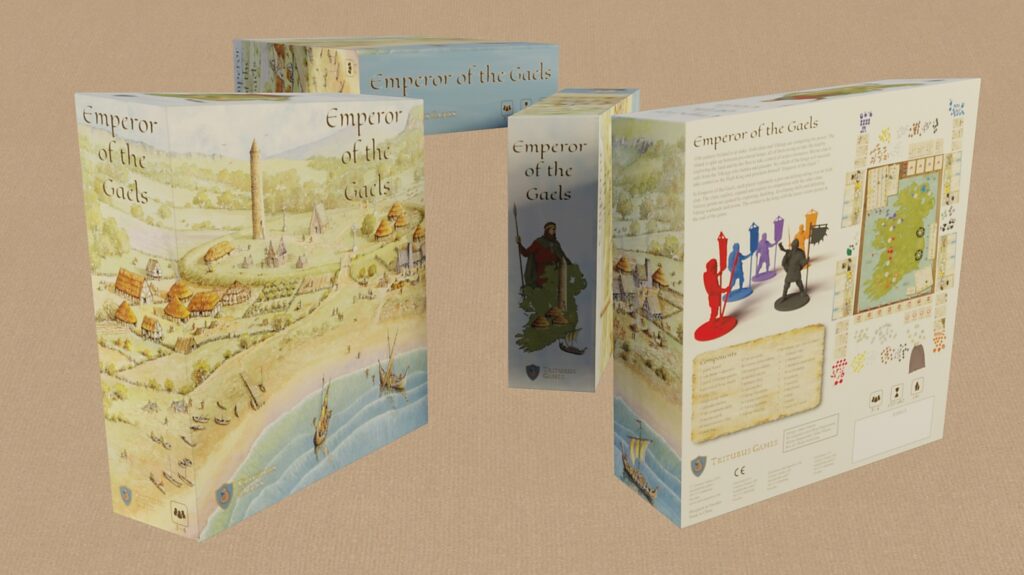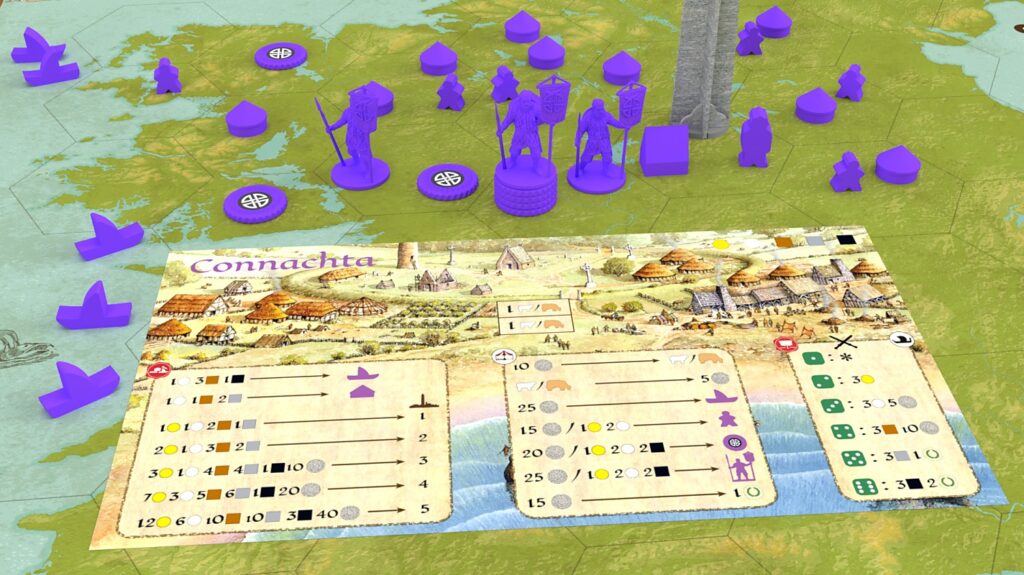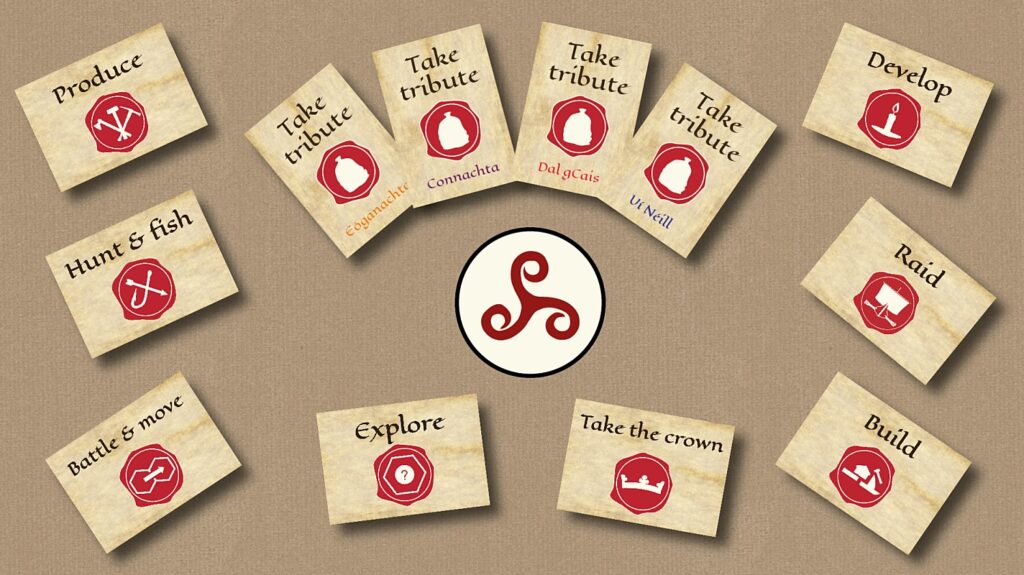
We commissioned the historical painter Phillip Armstrong to create a watercolour illustration for the game box. Over many years, Phillip has built a rich portfolio of historical paintings for museums and various institutions.
These paintings are created in collaboration with archaeologists and historians to recreate environments from the past, including many from medieval Ireland. We believe it’s an excellent way to breathe life into history.

As provincial kings, the players lead their own Irish clans, in early 11th century Ireland.
Victory is achieved by increasing the clan’s resources, constructing buildings, gaining control over territories, developing new knowledge, and enhancing military capabilities.
There are many choices and opportunities, but since the mechanics are learned one by one and repeated, the learning curve is low, and you will grasp the mechanisms after a first playthrough. However, mastering the game in-depth is an entirely different challenge.

The gameplay follows a seasonal calendar, with a recurring rhythm throughout the game’s four years, from 1011 to 1014.
This design gives the game its unique character, where kingdom-building, economics, and the military are interwoven. For example, the importance of a bountiful harvest to fuel a military offensive or the need to plan the construction of trading depots ahead of an upcoming market.
Many of these events can be executed in parallel, and the layout greatly facilitates the learning process.

Each player acts as the leader of an Irish clan. The clan has several pieces at its disposal, including a tower, a monastery, settlements, ships, workers, warriors, chieftains, and a trader.

The Actions event, is an important part of the game. Making strategic choices during this event is essential.
During each season, players perform actions selected from a variety of action cards. These actions allow players to explore new lands, build structures, produce resources, purchase development cards, initiate battles, move their units, go raiding, obtain food through hunting and fishing, acquire money and resources through tribute, or seize the crown to become the first in turn order.

The tower symbolizes the growth of the clan´s monastic village and is built of 5 levels, in the clan´s monastic area. A completely built tower ends the game and gives a lot of glory in the form of victory points.

Livestock and agriculture are crucial components of the game’s economic system. Cattle provide a steady source of food, while sheep also produce textile.
The cultivated fields yield harvests in the autumn. Both food and textile are vital resources for various game strategies, benefitting both builders and warriors.

It is important for a clan to build a stable resource production. When performing the Produce action, the clans may produce resources in their forests, mines and quarries.
Wood, stone and metal are used in the game mainly for building structures and ships but are also needed for example for buying development cards and recruiting warriors and chieftains.

Every summer and winter, fairs are held, where players in a communal marketplace buy and sell resources.
The trading system is dynamic; the game’s resources can vary in price depending on supply and demand.
Proper timing and planning for the upcoming markets can be an important path to victory.

The development cards allow your clan to develop their skills in a variety of areas, such as military skills or agricultural improvements.
Through the cards, you can build a unique competence for your clan, whether you are a builder, a trader or a warrior.

As a player of Emperor of the Gaels, you have to consider the presence of Vikings in Dyflinn and Veisafjordr.
The Viking warbands move randomly using a directional die in a system carefully calibrated to evenly distribute the threat across the game board.
Prepare your border defence against potential attacks, ready your fleet for upcoming raids, and perhaps even plan offensive actions to secure your victory.

The combat system in Emperor of the Gaels is straightforward yet still has tactical depth.
Battles are determined by the outcome of combat dice rolls in two interrelated clashes, where the results can be influenced by the use of military development cards. This provides tactical opportunities, as the cards are used in different parts of the battle.
A small but well trained warband with military development cards has significant potential to defeat a numerically larger but inexperienced opponent.

One of the most interactive elements in Emperor of the Gaels is the Viking raid, where players must decide whether to cooperate or pursue their own interests.

The game includes 15 chieftain miniatures, three for each clan and three for the Vikings.
The chieftain miniatures feature paint friendly details.

The rules in Emperor of the Gaels consists of 3 parts.
The quick reference guide is a good help when you have played the game a couple of times.
The Brehon Laws rulebook is detailed and with examples describe both the overall game flow, important concepts, the calendar events and the actions you may choose.
Finally, in the appendix you may find detailed information about for example concepts and all the development cards.

Expanding the kingdom is a crucial aspect of the game, not only to discover new resources to exploit but also to establish easily defensible borders and efficient logistics, as your units move faster within controlled territory.

Eight provincial kings with unique starting conditions, combined with four clans having unique starting positions, ensure variety and alternating challenges.
The path to victory is shaped by the special conditions of each game, providing also veteran players with an intriguing strategic puzzle over and over again.

The players always take clockwise turns, and the first player has advantages in the game. This player acts first in the market and is the first to choose actions and free development cards.
Other participants can take over this advantage by choosing the action ‘Take the crown’ and thereby become the new starting player.
This mechanism provides an interesting tactical choice, manoeuvring to the starting player position just before a significant market or crucial seasonal event can be very advantageous.
